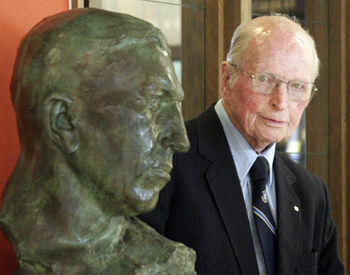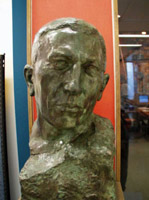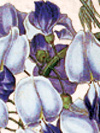| History of the Memorial Room Collection Page 6 |
|
||||||||||||||||||
 |
Expanded remarks by Professor Emeritus, Wm. C. Gibson, D.Phil.(Oxon) M.D., F.R.C.P., September 7, 1988 at the dedication of the Historical Collection of the Woodward Library, University of British Columbia. The Life Sciences Libraries thanks Dr. William Gibson for his kind permission to reproduce his historical comments on the Historical Collection of the Woodward Library. |
|||||||||||||||||
|
A few days after these investigations I found myself at medical historical meetings in Cambridge. Hanging over the bar one night was an aging but still pontificating surgeon. He asked me noisily what I was doing in England. When I explained, he roared that my search for a first edition of William Harvey was laughable. I reminded him that right there in Cambridge my friend Sir Geoffrey Keynes (brother of John Maynard) was said to have found two copies on the open shelves of a college library. Then my garrulous friend whispered into my ear that there was a rumor that a bookseller in Belfast had a first edition locked up in a bank vault for his young children. Next morning I telephoned to Miles Blackwell at Oxford asking him to send me to Vancouver by airmail the names of the reliable book dealers in Belfast. His letter followed me home and contained the names of six such establishments. I wrote a similar letter to each and despatched it by air. Soon five replies came back, one of which said that I should not mention it to anyone but it was believed that one dealer--whom he named--was thought to have the desired book. This was the dealer who failed to reply. Next morning I had my alarm clock wake me at 3 a.m., and I called the evasive dealer, hoping to catch him at his coffee. This is precisely what happened, and at first he feigned ignorance of any book, even of the location of British Columbia. After a little more trans-Atlantic brogue he asked how it was that the best kept secret in Europe was known to me in Vancouver. I replied that I would not like to discuss that sensitive matter on any telephone, but perhaps he would consent to see me in Belfast. A considerable silence followed, and finally he said "You'd better come". This called for a brief meeting with the Adonis-like figure, Bruce Samis, the stockbroker who had succeeded to the Chairmanship of the Woodward Foundation on Puggy's death. Bruce could smell a good deal a mile away and wished me well. Soon I was descending upon the green pastures over Londonderry where my ancestors had been farmers. At Belfast I was met by a most charming husband and wife who had gone into the book business rather recently. Over lunch they told me that their first big purchase was the library of a bankrupt lord. Few attended the auction and they had bought the books en bloc. Over the winter by their fireplace they went through the acquired books carefully, and could not believe it when they opened a thick volume, with no title, but with the date 1629 stamped on the spine. It turned out to be a series of tracts and reprints bound together-chiefly on how to take a bath, what to eat, and how to avoid the plague. In the middle of the melange they came upon the precious seventy-two pages of William Harvey's classic of 1628! Their eyes protruded at the sight of this rarity, for they knew there were only fifty copies in the world. They wisely put the bound volume in their bank safety deposit box against the future. Clearly these good people, with three young children were apprehensive about that future, and were much relieved when I outlined a plan whereby the Woodward Library would acquire the entire volume by paying into a bank in Vancouver an annual rental for the children's accounts. At the end of twenty years a final sum of one pound sterling would be paid to settle the indebtedness. This was run past the authorities and was approved, though they had not heard before of this method of doing business. It was agreed that the Harvey could be disbound from the rest of the volume at U.B.C., and the less valuable remainder would be sent back to Belfast. We were to keep the vellum binding. The volume was shipped by air express, insured for $100,000 which pleased the Woodward Trustees who had paid a great deal less for it. The twenty years have passed quickly. The university binder did a wonderful job, on reducing the fine vellum cover to fit the little Harvey and stamped the title and "1628" on the spine. There was some delay, however, in getting the finished product across campus. Percy Fryer the binder, whose English needed translation, was busy combing the second-hand clothing stores downtown in search of ladies' long gloves, fawn in color, from which to cut tying thongs. He inserted these perfectly into the closing edges of the "new" book. It sits now in a bullet proof glass case in the Memorial Room, weighted down with a few hundred pounds of concrete, lest the engineering students get frisky. The whiteness of the paper suggests that the book was never opened after 1629.
When our wonderful supporter and medical researcher Dr. Mollie Kidd died she left the Memorial Room a handsome bequest of $100,000 for the purchase of more medical milestones. Having operated the Overwaitea grocery empire of her deceased father until she was aged 40, she applied to McGill to study medicine! However reluctant the authorities may have been at the beginning they beamed when, at age 44, Mollie won the Holmes gold medal for heading her graduating class. The ever watchful Jake Zeitlin in Los Angeles, bookseller to the world called me one day offering the 3-volume set of Leonardo da Vinci's drawings, published during the first world war in Norway! He asked $750.00 for the set, in mint condition. I said soberly that I must make sure we did not already have these fine books in the Main Library. Within two minutes I had Noel Poynter on the line in London. He shouted: "Seven hundred and fifty dollars? They are worth that in pounds!". So back went the message to Los Angeles that we could just manage the purchase. The retiring Dean of Pharmacy, Dr. Whit Mathews arrived with two ancient and beautiful pharmacy jars, too large for his home. They now grace the mantlepiece in the Memorial Room. Dr. Iser Steiman, my boon companion from Air Force days when we worked on his translation of the Russian aviation medicine text, brought in a second edition of Vesalius, enlarged and corrected from the first edition. Soon Iser was back with six boxes containing the finest collection ever put together of postage stamps illustrating great contributors to the health field--both doctors and nurses from every conceivable country. One of his patients, a physician, spent the last years of his life in bed with a crippling heart disease, and had occupied his time productively with his specialized philately. His family, upon his death, could not agree on who should get what part of this set of master volumes, so Dr. Steiman prevailed upon them to put them on "indefinite loan" in the Memorial Room. They need to be more frequently exhibited in the locking glass display cases in the foyer. They are priceless, beautiful and instructive. |
||||||||||||||||
|
||||||||||||||||

 These
high-powered negotiations were interspersed with less exacting forays.
Dr. Ballard, of dog-food fame, had known in Ontario, Sir Frederick Banting,
the discoverer of insulin for the treatment of diabetics. It took a little
time to interest him in acquiring a copy of the fine bronze Banting bust
sculpted by Frances Loring in Toronto. She gave instant permission to
have a sixth one cast at the foundry in New Jersey. The whole thing was
a well kept secret, something on which the diminutive Dr. Ballard insisted.
The cat almost jumped out of the bag, however, when he had a slight motor
car accident as he tried to park his Rolls-Royce at the Faculty Club where,
over lunch, we were to finalize the unveiling ceremony. He piloted his
massive vehicle by looking through the steering wheel and unfortunately,
but predictably, cut the rear end off Bert Binning's new red convertible
which was parked at the club. I was deputed to carry the great veterinarian's
card, along with his regrets to the owner, with the request to get in
touch with his company's lawyer at once, rather than the police.
These
high-powered negotiations were interspersed with less exacting forays.
Dr. Ballard, of dog-food fame, had known in Ontario, Sir Frederick Banting,
the discoverer of insulin for the treatment of diabetics. It took a little
time to interest him in acquiring a copy of the fine bronze Banting bust
sculpted by Frances Loring in Toronto. She gave instant permission to
have a sixth one cast at the foundry in New Jersey. The whole thing was
a well kept secret, something on which the diminutive Dr. Ballard insisted.
The cat almost jumped out of the bag, however, when he had a slight motor
car accident as he tried to park his Rolls-Royce at the Faculty Club where,
over lunch, we were to finalize the unveiling ceremony. He piloted his
massive vehicle by looking through the steering wheel and unfortunately,
but predictably, cut the rear end off Bert Binning's new red convertible
which was parked at the club. I was deputed to carry the great veterinarian's
card, along with his regrets to the owner, with the request to get in
touch with his company's lawyer at once, rather than the police. 
